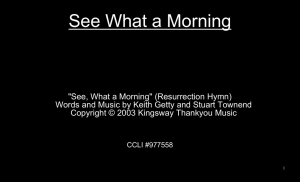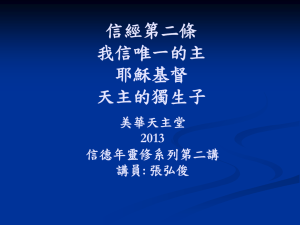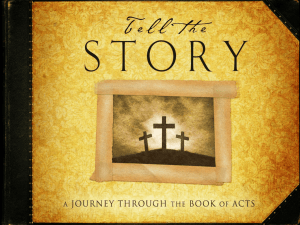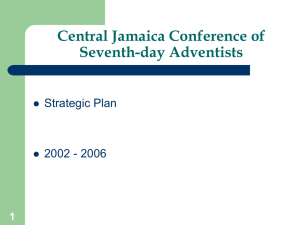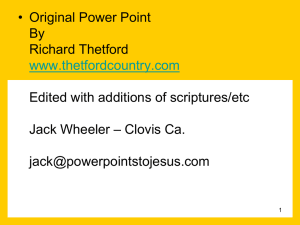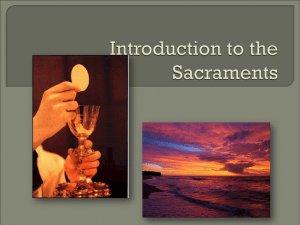File
advertisement
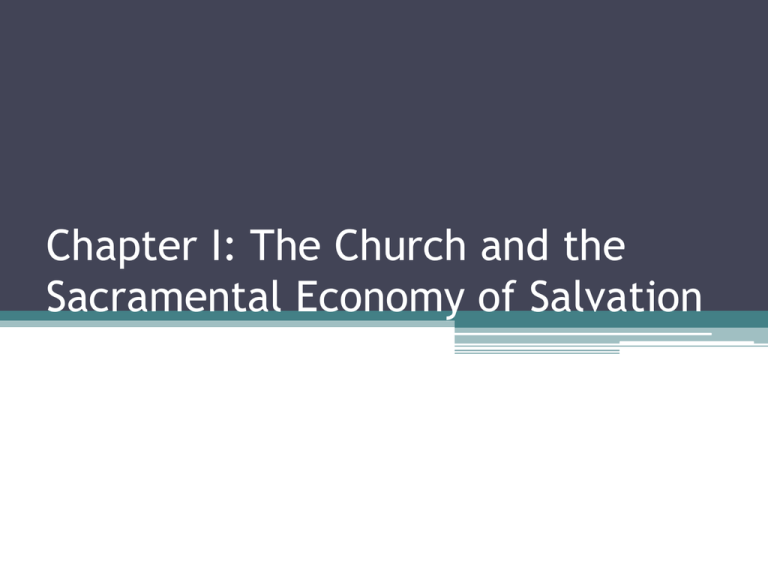
Chapter I: The Church and the Sacramental Economy of Salvation The Incarnation • God becoming man and taking on human flesh like us is referred to as the mystery of the Incarnation Luke 1:26-38 26In the sixth month the angel Gabriel was sent from God to a city of Galilee named Nazareth, 27to a virgin betrothed to a man whose name was Joseph, of the house of David; and the virgin's name was Mary. 28And he came to her and said, "Hail, full of grace, the Lord is with you!" 29But she was greatly troubled at the saying, and considered in her mind what sort of greeting this might be. 30And the angel said to her, "Do not be afraid, Mary, for you have found favor with God. 31And behold, you will conceive in your womb and bear a son, and you shall call his name Jesus. 32He will be great, and will be called the Son of the Most High; and the Lord God will give to him the throne of his father David, 33and he will reign over the house of Jacob for ever; and of his kingdom there will be no end." 34And Mary said to the angel, "How shall this be, since I have no husband?" 35And the angel said to her, "The Holy Spirit will come upon you, and the power of the Most High will overshadow you; therefore the child to be born will be called holy, the Son of God. 36And behold, your kinswoman Elizabeth in her old age has also conceived a son; and this is the sixth month with her who was called barren. 37For with God nothing will be impossible." 38And Mary said, "Behold, I am the handmaid of the Lord; let it be to me according to your word." And the angel departed from her. Various Artistic Renditions of the Incarnation Which depiction “speaks” to you the most? Sacraments • St. Augustine – “visible signs of invisible grace”. To understand the Sacraments, we must make invisible visible. Jesus Christ Is the Sacrament of God • Sacramental Economy – the system that Christ uses to make Himself and his saving graces present to us, using the liturgy • Liturgy – official public worship of the Church; the Mass is the most important one. • Jesus’ desires to share our life, our tragedies and joys; this is accomplished in the Church’s liturgy. Christ is the Prime Sacrament • Jesus is also a “mystery” that cannot be fully explained or understood. • The Mystery of how Jesus can be fully man yet fully divine at the same time is referred to as the hypostatic union. • New Testament – gives us a glimpse of the historical Jesus and His words and actions of proclaiming the Good News of Salvation. This was recorded by the four evangelists. How is Jesus a Sacrament? • Sacrament – an outward visible sign of an invisible grace • Jesus is the perfect, most complete visible sign of the Father’s presence and love • Definitions: Jesus, Christ, Messiah Jesus as the primordial sacrament • Jesus is the only way to God the Father • Jesus is the reason for, and the basis of, all Seven Sacraments • Jesus is an efficacious sign for He effects and makes present the love of God • Summary: Jesus points to God’s love while at the same time He is God’s love for us as He reconciles the world to His Father Sacramentals: “Mini-signs” of God’s presence What are “sacramentals” • A Sacrament is an outward sign instituted by Christ for the purpose of giving grace to our souls; sacramentals are also an outward signs, but unlike sacraments they do not give us grace, rather they dispose us to grace or they arouse in us feelings of faith and love. • A sacramental can be used as an instrument of God’s grace. • The effectiveness of a sacramental depends on our own interior faith in God and personal prayer life. • Sacramentals can be things or actions. Examples (things): • • • • • • • • Candles Ashes Palms Crucifixes Medals Rosaries Scapulars Images of Jesus and Mary; images of the saints Examples (actions) • Blessings – objects, places, and individuals • Exorcisms – a special kind of sacramental in which the Church, in Christ’s name, commands the devil to leave the body of whom he has taken possession. • Notes on Exorcism: requires investigation to rule out mental disturbance; only a bishop or a priest appointed by the bishop can perform the ritual; rarely takes place, but when they do the church insists respect and secrecy Review: Three dimensions of a Sacrament 1. A sacrament is a mystery 2. A sacrament is a visible sign of the unseen divine reality. 3. A sacrament is an efficacious sign – something that makes real what it signifies. Three dimensions of the Church I. The Church is a mystery (Ephesians 5:32) A. The New Testament writers described the Church in symbolic language and images: • Sheepfold (Jn. 10:1-18)* • Flock of sheep (Jn. 21:15-19) • Field or a vineyard that needs to be cultivated (Jn. 15:1-10) • Building of God (Eph. 2:19-22)* • Bride of Christ and Mother (Eph. 5:25-27) • New Jerusalem (Kingdom of God) (Rev. 21:927) Three dimensions of the Church con’t… II. The Church is the visible sign of the unseen divine reality • The Church is the visible sign of Jesus Christ, who is the perfect sign of the Father’s saving love. • And as the visible sign of Christ’s presence in today’s world, the Church has four characteristics or marks: ONE, HOLY, CATHOLIC, APOSTOLIC Commercial: Catholics Come Home The Four Marks of the Church • The marks of the Church can be seen as a “genuine trademark”. Marks of the True Church of God. 1. The Church is ONE • One in belief and doctrines– the truths that we profess come from God and not our own private opinions; we believe that God’s truths are unchangeable and same for all people • One in worship – Catholics can go anywhere in the world and feel at home spiritually; everywhere the same Mass, everywhere the same seven sacraments • One in spiritual leadership or government – Catholics have a binding center of authority in the bishops and the Pope (Holy Father) The Four Marks of the Church con’t… 2. The Church is HOLY • The founder of the Catholic Church is Jesus Christ • The teachings of the Church are holy and consistent on matters of faith and morality • The countless saints and martyrs are proofs of the holiness of the Church and divine origin • The Church provides the means for all of us to be saints. The Four Marks of the Church con’t 3. The Church is CATHOLIC • “catholic” means “universal” • The Catholic Church has been in existence at all times from the time of the apostles to the present day. It is the only Church that has been in continuous existence for 2,000 years. • The Catholic Church is the only Church that teaches all truths taught by Jesus as He taught them (i.e. Penance, Anointing of the Sick, Real Presence of Jesus in the Eucharist, the Pope, etc.) • The Catholic Church has been universal in extent – it’s in every country; it belongs to no nation or race; it is at home at every land, but is the property of none The Four Marks of the Church con’t 4. The Church is APOSTOLIC • It’s leaders (popes, bishops, priests) and authority traces their succession all the way back to the first apostles, to whom Jesus established His Church. • The Church teaches intact the teachings and traditions of the apostles. Homework • Complete summer reading • Read pages 21-23 and do Review Questions on page 23 • Organize your notebooks/binders; Notebook Test on Thursday The Mission of the Church, the Body of Christ “As the body is one, though it has many parts, and all the parts of the body, though are many, are one body, so also Christ. For in one Spirit we were all baptized into one body.” ~ 1 Corinthians 12:12-13a The Church as the Body of Christ • This image reminds us that as members of the Church, we become a member of the Mystical Body of Christ, with Christ as it’s head. • This idea affects our understanding of our relationship with God, with one another and the rest of the communion of saints (all the members of Christ’s Body in heaven , earth, and purgatory). The Body of Christ: types of communion 1. The Communion with Christ and the Church • Whenever we things Christ did in His name (Mt. 25:34-40), we grow in our communion with Christ and the Church. • Whatever we do as Catholics, we act as the Body of Christ, as Christ Himself in today’s world. The Body of Christ con’t… 2. Communion with Other Catholics • Unity with our fellow Catholics around the world in union with our bishop and in union with the Pope. • This is strengthened whenever we pray for the Pope and bishops, and encourage unity among one another, especially in our communities. The Body of Christ con’t… 3. Communion with other People throughout the world. • The Church is joined, albeit imperfectly, with our fellow Christians. • The Church shares some unity with non-Christians – such as the Jewish people (who first received God’s covenant), and with the Muslims who profess a belief in the one God. • The Church shares some unity with all people of goodwill. • Human Solidarity -- We see our interconnectedness with one another as as brothers and sisters in Christ. We share in the joys and sufferings of all humanity. • Social Justice -- Catholics work together with believers and unbelievers alike to promote the dignity of life, just laws, and the common good. The Body of Christ con’t… 4. Communion of Saints • Our unity with all the living faithful, and all the deceased – in heaven and purgatory. • This unity has two meanings: communion in the spiritual goods and communion with all the holy people in heaven and earth Communion of Spiritual Goods • Communion of Faith – we share the same beliefs we inherited from the apostles. • Communion of the Sacraments – the sacraments unite us to God and with our fellow believers on earth, heaven, and purgatory. • Communion of Charisms – we collectively share in the gifts or charisms of every individual who uses them to build up the Church and for the good of all. • Communion of Goods – we share our goods with others, especially the poor. • Communion in charity – every good act benefits the whole Body of Christ; every sin harms harms the Body of Christ Communion of all holy people • The saints in heaven prays and intercedes for the living and those being purified in purgatory; • The living prays for strength and aid from the saints in heaven, • The living prays as well for those who have died. The Church, the Channel of Grace • Through the Church we are transformed into the Body of Christ We become the Church – a sign and instrument of Christ’s presence in the world. How does each of the Seven Sacraments transform us as Church? (See Page 21) • Baptism – makes us members of the Church; we are reborn as children of God. • Confirmation – our union with Christ and the Church is strengthened; we are given the gifts of the Holy Spirit to help us spread and defend the Catholic faith. • Eucharist – we are nourished and strengthened by Jesus in the Eucharist. • Penance or Reconciliation – forgives sins and restores our unity with God and the Church • Anointing of the Sick – strengthens the sick and the suffering; helps them to unite their sufferings to the passion and death of Christ • Holy Orders – enables bishops, priests, and deacons to nourish the Church with the word of God and the Sacraments • Matrimony – strengthens couples in their marriage to help one another become holy, build their lives together, and build up the church by accepting and educating their children in the faith. Our three-fold mission as priests prophet and king • By carrying out the mission of Christ in today’s world we share in his mission as priest, prophet, and king Our Mission as “Priests” • Not the same as the ministerial/ordained priesthood of bishops and priests. • All who had been baptized as “priests” because all are called to offer themselves to God in worship, become holy, and help others grow in holiness • to become holy – we become united with God in grace. ▫ Each sacrament enables us to share God’s life in a particular way – this type of grace that we receive is called sacramental grace. Types of Grace • Sacramental Grace • Sanctifying Grace – a sharing in the life God that transforms us and makes us holy • Actual Grace – a specific divine help that enables us to perform a good act such as forgiving, avoiding a habitual sin, and being courageous in doing the right thing. • We have to be in the state of grace (free from mortal sin) in order for grace to increase or take effect. • Grace transforms and increases in us the virtues of faith, hope, and charity (theological virtues) Our Mission as “Prophets” • Whenever we witness to truth in our words, actions, and examples; as well as when we encourage others, we share in Christ’s mission as prophet. • The laity (those baptized but not ordained), shares in the prophetic mission by allowing their faith to transform the world around them (at home, work, schools – the public) and bring others to Christ. Our Mission as “King” • Whenever we work for justice, peace, and serve others in charity, we share in Christ’s mission as king. • The Church carries out this “royal mission” through its work in the missions, the poor and homeless, educational ministries, etc. Conclusion: threefold mission • Whenever we involve ourselves in the threefold mission of Christ as priest, prophet, and king, we become a sign and instruments of Christ’s presence, we become a type of sacrament.



